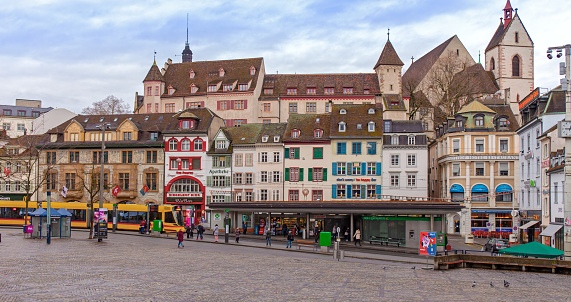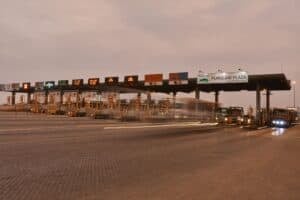This riverside city in Switzerland is also the birthplace of Roger Federer, has some 40 museums and is currently on the cusp of Carnival.

Basel is, perhaps, the only city in the world that’s best experienced at 4am on a Monday. On a particular Monday, that is – the one after Ash Wednesday, when nearly every local with a pulse turns up in the Old Town for a parade known as the Morgenstreich.
Then, on the fourth chime of the bells at Basel’s oldest church, all the lights of the city are turned off, and costumed marching bands called “cliques” fire up a tune to signal the start of Basel’s Fasnacht.
This uniquely exhilarating, 72-hour Lenten Carnival illustrates an essential truth about this cosmopolitan riverside city of 170,000 that hugs Alsace and the Black Forest.
Basel may be best known for Art Basel, the world’s biggest art fair, for its museums and pharmaceutical companies, and as the birthplace of the tennis legend Roger Federer. But it is, above all, a city of traditions, none more cherished than Fasnacht ( 2-5 March), which locals call the three best days of the year.
Travellers on quick grand tours of the Continent might overlook Basel, which is a shame because it boasts an Old Town as lovely as any in Europe, a collection of 40 museums, and hospitable locals.
In an era in which the world’s most popular destinations are often under siege with too many tourists, underrated but equally alluring places like Basel deserve a second look.

Strolling along the banks of the Rhine in Basel. Picture: Clara Tuma / The New York Times
Friday
1) 3 p.m. Rhine time
Start your weekend adventure in Kleinbasel along the banks of the Rhine, the lifeblood of this city since a Celtic tribe first settled along this bend in the river during the Bronze Age.
The Kleinbasel (Lesser Basel) side is a great place for a riverfront ride on an ebike, available at the main train station for 20 Swiss francs (R310) a day, with a BaselCard (free with any hotel stay, also includes 50% off museum admissions and other perks).
But if you want to become an honorary Basler, you’ve got to also feel the current of the river. In the summer, swimming in the cool, clean Rhine and then repairing to a riverside buvette (stall) for a drink or snack is the quintessential Basel tradition.
Another tradition, which can be done year-round (weather permitting), is crossing over to Grossbasel (Greater Basel) on one of the city’s four wooden ferry boats (1.60 francs), which use only the natural power of the river’s currents.
2) 4 p.m. Basel’s medieval power couple
Basel’s cathedral was consecrated 1,000 years ago on 11 October 1019, on the site of an earlier church and in the presence of the Holy Roman Emperor, Henry II (who became the patron saint of Basel) and his wife, Cunigunde. The two were a medieval power couple who took vows of virginity and inspired a cultlike following.
It’s an awe-inspiring place best seen with a knowledgeable guide like Dr Helen Liebendörfer, a charming, English-speaking guide who will show you fascinating sites here and elsewhere in the city you’d otherwise walk by without a second look.
Inside, don’t miss the grave of Erasmus of Rotterdam, who settled in Basel and lived for a time in a home that’s now an interesting pharmacy museum.
3) 6 p.m. Live it up a little
You might not have the francs to splash out on a room at the opulent, five-star Grand Hotel Les Trois Rois, but you should absolutely change into your least wrinkled outfit and head over to the hotel bar for a drink.
This chandelier-filled grande dame, founded in 1681, is one of the oldest and finest city hotels in Europe.
In fine weather, try to score a seat outside with a sweeping view of the Rhine, otherwise, cozy up by the fireplace and soak up the elegant atmosphere. A glass of the house rosé costs 9 francs; a cheeseburger and fries, about 48 francs.

The Helvetia statue at the Rhine river. Picture: iStock
4) 8 p.m. Steeped in atmosphere
Schlüsselzunft is an Old World charmer of a restaurant in a guildhall building that dates to 1306 on a pedestrian street in Basel’s delightful Old Town.
The upstairs has a pleasing Knights of the Roundtable ambience and the ground level has a ceramic stone oven that dates to 1850 in the centre of the dining room.
The menu changes frequently, but recent standout menu items here included Kalbsleberstreifen, sliced veal liver with Madeira sauce (36 francs), and Rehgeschnetzeltes, venison strips with forest mushrooms in a cream sauce (38 francs).
Saturday
5) 9 a.m. Big Basel versus Little Basel
Start your Saturday with a slow walk across Mittlere Brücke (Middle Bridge), just as Baslers have since it opened in 1226. Take note of the small chapel (Käppelijoch), a reproduction of an old bridge chapel where suspected witches, adulterers and condemned criminals were tossed into the Rhine.
Walk toward Grossbasel and right after you leave the bridge, look up at the statue of the king with his tongue sticking out at Kleinbasel. Make your way on foot to Andreasplatz, a charming square that comes alive during Fasnacht.
There’s a collection of interesting shops, a statue of a monkey eating grapes, and tucked in the back corner, Holzofenbäckei Bio Andreas, a terrific and rather quirky organic bakery that has a love letter to its wood oven on its website. (“Dear oven, you are so hot and smoky … you turn me on.”)

Picture: Clara Tuma / The New York Times
6) 10 a.m. Just like old times
Basel’s Old Town is a paradise for aimless wandering. Three of the city’s original seven gates are intact and many homes have their year of construction painted above their doorways.
Venture down the steps to No. 31 Ginger Street, and you’ll find the irresistible Hoosesagg Museum, a tiny museum that features a different themed collection of miniatures each month, courtesy of community members who loan the museum everything from Eiffel towers to ceramic turtles.
There are more hidden stories on every block — for example, English speakers might pass a fascinating alley called Elftausendjungfern Gässlein (11,000 Virgins Lane) without a second glance. The name speaks to a cherished legend about 11,000 virgins, followers of St. Ursula, who arrived in town by boat in medieval times and were eventually martyred in Cologne.
7) 12:30 p.m. Roger’s neighborhood
With apologies to Erasmus, Roger Federer is probably Basel’s most famous native son.
He grew up in the Basel suburb of Munchenstein in a townhouse in the Wasserhaus housing estate and honed his game first at the long bulldozed Ciba-Geigy club and later at the still-thriving Tennis Club Old Boys, where Court 1 is named after him.
Get on the No. 8 tram to the Bernerring stop to visit the club, where you can take a tennis lesson (call in advance) and then enjoy one of the best kept secrets in town: a 20-franc, three-course lunch at La Vongola, the club restaurant.
The pastas are all great. If you don’t fancy the daily menu, try the strozzapreti (Italian for priest strangler) with fresh seafood (29.50 francs).
8) 3 p.m. Erotic chocolate
Now it’s time to buy all the Swiss chocolate you can afford at Läderach, one of the country’s leading chocolatiers. Basel has a small red light district in Kleinbasel, but the most erotic experience in town is simply walking into this shop and inhaling the smell of fine chocolate.
The blocks of frischschoggi — silky Swiss milk chocolate with giant Piedmont hazelnuts — could have won the Cold War (if only Switzerland hadn’t been neutral).
If you’d like to bring something home that won’t melt, pick up a box of Basler läckerli — a gingerbread biscuit that has inspired cult-like devotion in these parts since the Middle Ages — at Läckerli Huus (three locations).
Walk it all off on Spalenberg, one of the city’s nicest shopping streets, home to shops like Hejkoh, which has stylish women’s clothing, home décor, gifts and a cozy cafe where the avocado-toast-loving set likes to gather for treats and conversation.

Barfuesserplatz square. Picture: iStock
9) 7 p.m. Cordon bleu paradise
At Zum Gifthüttli Bier & Weinstube in Old Town, you’ll find a convivial atmosphere of good times, spilled beer and undo-a-notch-on-your-belt gluttony. The specialities of the house are cordon bleus of various meaty assortments.
Menu items include venison steaks, boar pepper steak, deer cordon bleu and the like. Try the veal cordon bleu schwinger filled with farmer’s bacon and nöldis cheese (34 francs).
If you passed on Läderach, you’re entitled to the chocolate lava cake with housemade vanilla ice cream, which is absolutely worth the long walk you’ll need to take to work off the calories.
Keep the good times rolling with a craft beer or two at Volta Bräu, a fun brewpub that frequently has free live music or at Matt & Elly Brewery & Kitchen, a newly opened hot spot in Kleinbasel with seasonal beer and food menus.
Sunday
10) 10 a.m. Paperboys’ brunch
Basel became a centre for humanism and publishing following the establishment of the University of Basel in 1460, attracting a host of noteworthy writers and scholars, most notably Erasmus, who published the New Testament in Greek in 1516.
Basel’s tourism office operates an excellent Sunday brunch tour (50 francs) that includes a tour of the Basel Paper Mill and a delicious brunch at the museum’s restaurant.
Set in a lovely canalside paper mill that was operational for more than 500 years in Basel’s charming St. Alban-Tor neighbourhood, the child-friendly museum offers fun hands-on exhibits that illuminate the history of printing, paper and writing.

Picture: Clara Tuma / The New York Times
11) Noon. Picasso time
Basel is a museum city par excellence, with 40 to choose from, including two powerhouse art museums: the sprawling Kunstmuseum Basel (25 francs, half price with BaselCard; children free), which is free the first Sunday of each month, and the small, but worthwhile, Fondation Beyeler (25 francs, half price with BaselCard; free for 25 and under) in a light-filled Renzo Piano-designed building in a pretty area of Riehen, north of the city.
The Kunstmuseum started as a private art cabinet in the 16th century and is now a world-class museum that’s known for its collection of six works by Pablo Picasso, including one of his Seated Harlequin works.
In 1967, after the museum was about to lose two Picassos — the private collector who owned them was in debt and needed to sell — local art lovers mobilised, spearheading the passage of a referendum allowing the city to buy them for 8.4 million francs. Picasso was so moved that he gave the museum three more paintings and a drawing.
12) 2 p.m. Garden walk
Just a few minutes south of Fondation Beyeler, you’ll find a lovely, relaxing place to cap your weekend: the underrated Villa Wenkenhof, a stately English-style villa built in 1735 with beautiful gardens that are free and open to the public every day but Saturday.
Roger Federer and Mirka Vavrinec were married here; you can roam the grounds and take photos in the same spot they did in front of the grand former horse stable to the left of the main villa.
For more news your way, download The Citizen’s app for iOS and Android.






